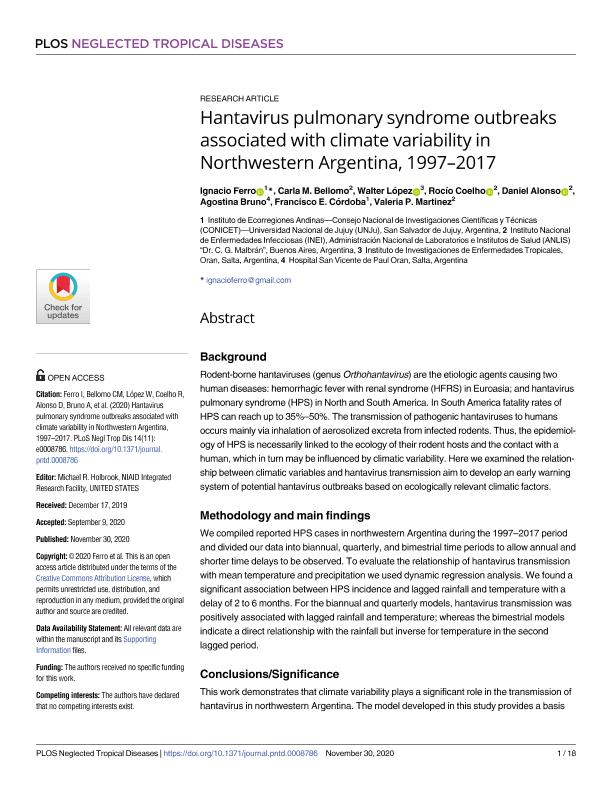Artículo
Hantavirus pulmonary syndrome outbreaks associated with climate variability in northwestern Argentina, 1997–2017
Ferro, Luis Ignacio ; Bellomo, Carla María; López, Walter; Coelho, Rocío María; Alonso, Daniel; Bruno, Agostina Alejandra; Cordoba, Francisco Elizalde
; Bellomo, Carla María; López, Walter; Coelho, Rocío María; Alonso, Daniel; Bruno, Agostina Alejandra; Cordoba, Francisco Elizalde ; Martinez, Valeria Paula
; Martinez, Valeria Paula
 ; Bellomo, Carla María; López, Walter; Coelho, Rocío María; Alonso, Daniel; Bruno, Agostina Alejandra; Cordoba, Francisco Elizalde
; Bellomo, Carla María; López, Walter; Coelho, Rocío María; Alonso, Daniel; Bruno, Agostina Alejandra; Cordoba, Francisco Elizalde ; Martinez, Valeria Paula
; Martinez, Valeria Paula
Fecha de publicación:
11/2020
Editorial:
Public Library of Science
Revista:
PLoS Neglected Tropical Diseases
ISSN:
1935-2735
Idioma:
Inglés
Tipo de recurso:
Artículo publicado
Clasificación temática:
Resumen
Background Rodent-borne hantaviruses (genus Orthohantavirus) are the etiologic agents causing two human diseases: hemorrhagic fever with renal syndrome (HFRS) in Euroasia; and hantavirus pulmonary syndrome (HPS) in North and South America. In South America fatality rates of HPS can reach up to 35%–50%. The transmission of pathogenic hantaviruses to humans occurs mainly via inhalation of aerosolized excreta from infected rodents. Thus, the epidemiology of HPS is necessarily linked to the ecology of their rodent hosts and the contact with a human, which in turn may be influenced by climatic variability. Here we examined the relationship between climatic variables and hantavirus transmission aim to develop an early warning system of potential hantavirus outbreaks based on ecologically relevant climatic factors. Methodology and main findings We compiled reported HPS cases in northwestern Argentina during the 1997–2017 period and divided our data into biannual, quarterly, and bimestrial time periods to allow annual and shorter time delays to be observed. To evaluate the relationship of hantavirus transmission with mean temperature and precipitation we used dynamic regression analysis. We found a significant association between HPS incidence and lagged rainfall and temperature with a delay of 2 to 6 months. For the biannual and quarterly models, hantavirus transmission was positively associated with lagged rainfall and temperature; whereas the bimestrial models indicate a direct relationship with the rainfall but inverse for temperature in the second lagged period. Conclusions/Significance This work demonstrates that climate variability plays a significant role in the transmission of hantavirus in northwestern Argentina. The model developed in this study provides a basis for the forecast of potential HPS outbreaks based on climatic parameters. Our findings are valuable for the development of public health policies and prevention strategies to mitigate possible outbreaks. Nonetheless, a surveillance program on rodent population dynamics would lead to a more accurate forecast of HPS outbreaks.
Archivos asociados
Licencia
Identificadores
Colecciones
Articulos(INECOA)
Articulos de INSTITUTO DE ECORREGIONES ANDINAS
Articulos de INSTITUTO DE ECORREGIONES ANDINAS
Citación
Ferro, Luis Ignacio; Bellomo, Carla María; López, Walter; Coelho, Rocío María; Alonso, Daniel; et al.; Hantavirus pulmonary syndrome outbreaks associated with climate variability in northwestern Argentina, 1997–2017; Public Library of Science; PLoS Neglected Tropical Diseases; 14; 11; 11-2020; 1-18
Compartir
Altmétricas



